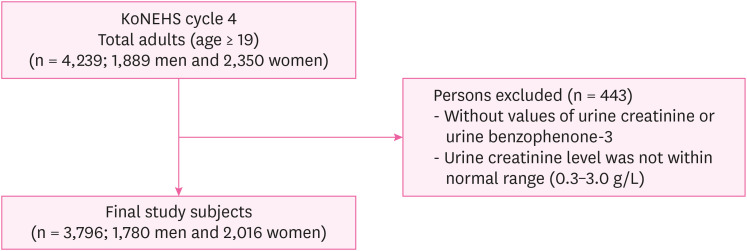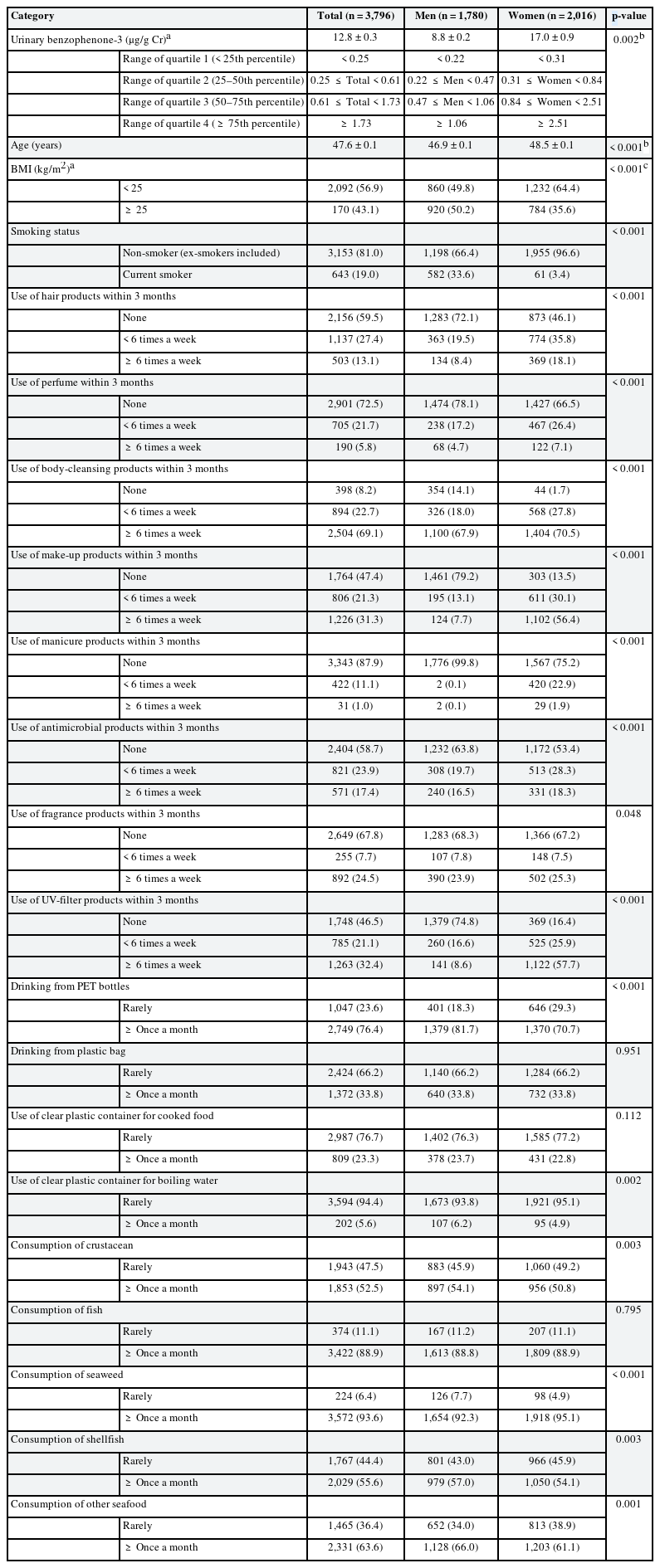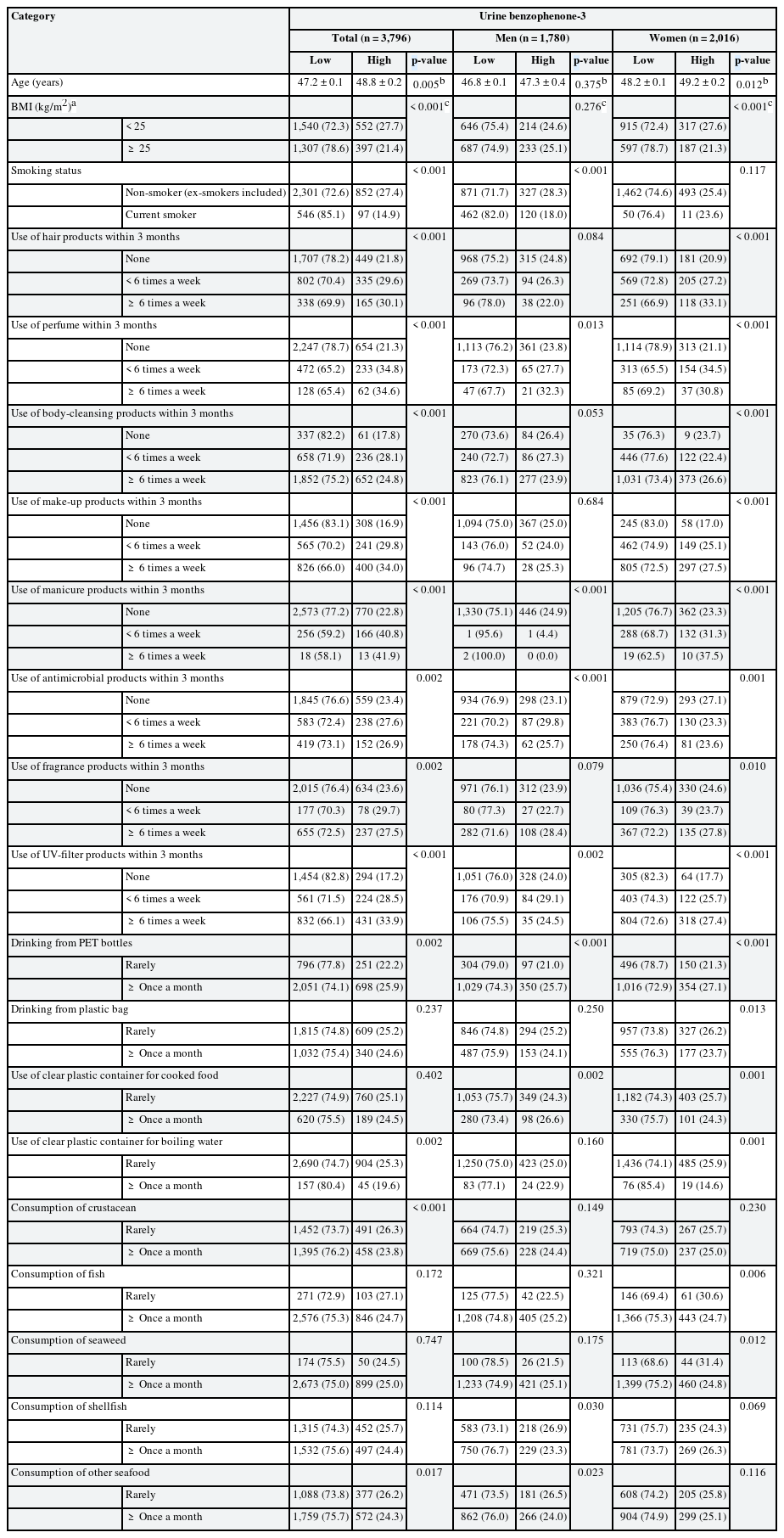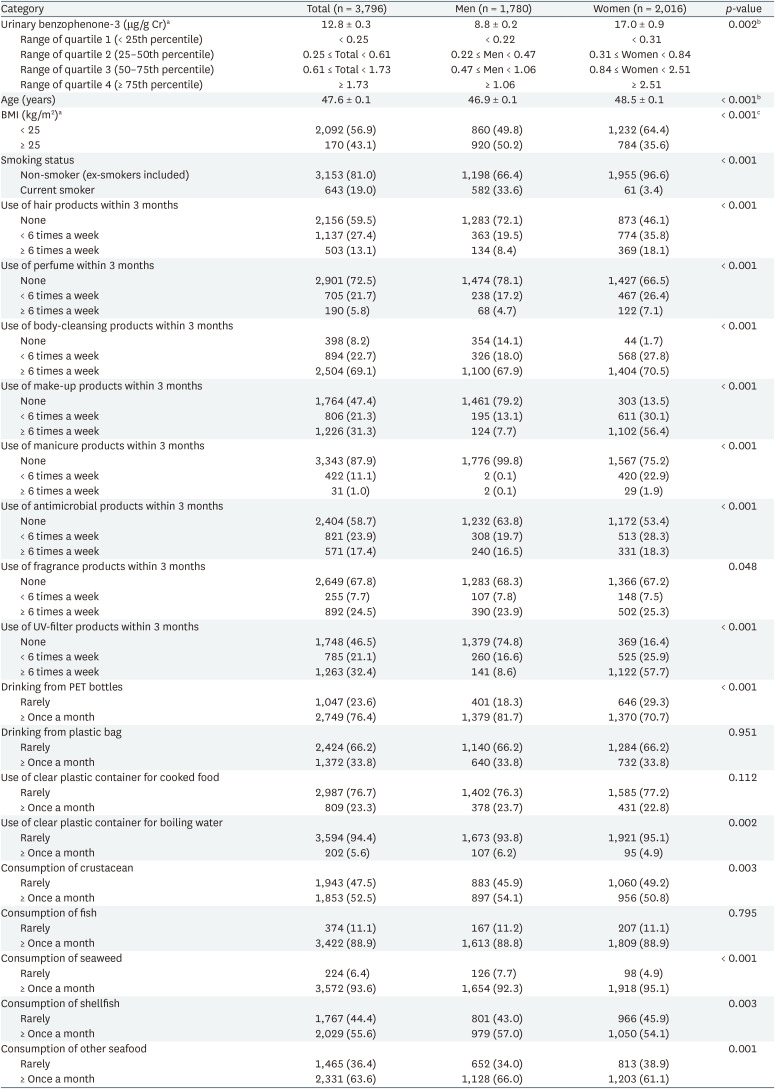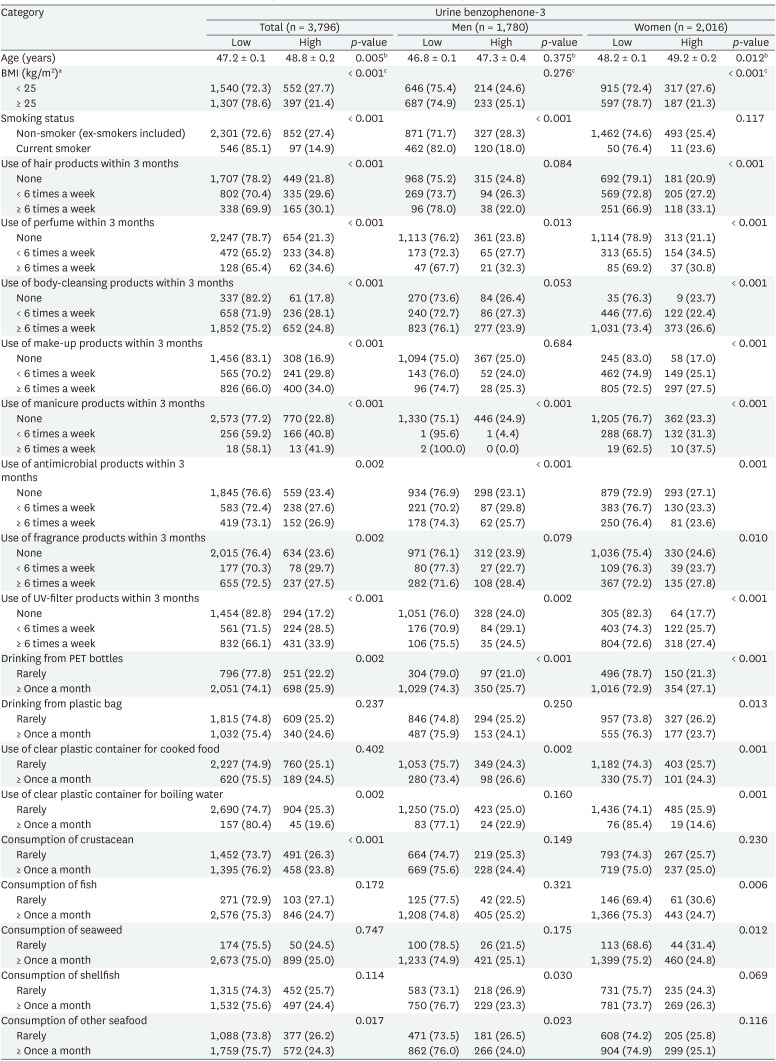Relationship between the use of hair products and urine benzophenone-3: the Korean National Environmental Health Survey (KoNEHS) cycle 4
Article information
Abstract
Background
Benzophenone-3 is a type of ketone with 2 benzene rings attached to a carbonyl group (C=O) and one benzene ring attached to a hydroxyl group (-OH). As an endocrine-disrupting chemical, benzophenone-3 is known to be associated with reproductive, developmental, thyroid, and endocrine toxicities. Benzophenone-3 is commonly used in hair products, cosmetics, and ultraviolet (UV) filters because of its characteristic property to absorb UV light. This study aims to investigate the association between the use of hair products and urine benzophenone-3 using the data from the Korean National Environmental Health Survey (KoNEHS) cycle 4 (2018–2020), which represents the Korean population.
Methods
Using the KoNEHS cycle 4 survey, the data of 3,796 adults aged ≥ 19 years were analyzed. Based on the 75th percentile concentration of urine benzophenone-3, the participants were divided into the low- and high-concentration groups. Chi-square test was conducted to analyze the association of urine benzophenone-3 with distribution of general characteristics, use of personal care products, consumption of marine foods, and use of plastic products as the variable. Logistic regression analysis was conducted to calculate odds ratios (ORs) for the high-concentration group of urine benzophenone-3 based on the use of hair products.
Results
Women with < 6 times or ≥ 6 times of hair product usage had significantly higher adjusted ORs compared to those who did not use hair products. The calculated ORs were 1.24 (95% confidence interval [CI]: 1.12–1.38) for women with < 6 times of usage and 1.54 (95% CI: 1.33–1.79) for women with ≥ 6 times of usage.
Conclusions
This study revealed the association between the use of hair products and the concentration of urine benzophenone-3 in the general Korean population.
BACKGROUND
Benzophenone-3 is a type of ketone with 2 benzene rings attached to a carbonyl group (C=O) and one benzene ring attached to a hydroxyl group (-OH).123 Among various benzophenone derivatives, benzophenone-3 is commonly found in the human matrix such as urine, blood, and breast milk.245 However, benzophenone-3 has recently been reported to be an endocrine-disrupting chemical with a negative impact on the human body26 as well as the aquatic ecosystem when released into the river and sea.4578
Benzophenone-3 has a characteristic property to absorb ultraviolet (UV) A (320–340 nm), UVB (290–320 nm), and UVC (200–280 nm) rays.910 Because of this property and low cost, benzophenone-3 is commonly used in hair products, cosmetics, UV filters, textiles, fibers, plastics, and paints.291112 Hair products include products for cleansing, conditioning and treatment, hair styling, coloring and bleaching, and perming or relaxing.13 Benzophenone-3 is added to hair products to protect the skin and prevent the degradation of hair product components.
So far, many studies have reported on the association of urine benzophenone-3 with UV filters, make-up products, lotions, and plastic containers, but only few studies have investigated the association between urine benzophenone-3 and hair products.1415161718 In addition, previous studies were based on small number of participants141618 and have focused on comparing urine benzophenone-3 concentration of personal care product users with nonusers while overlooking the frequency of use.16 Therefore, this study aims to determine the association between the urine benzophenone-3 and the use of hair products in general Korean population using the data of the Korean National Environmental Health Survey (KoNEHS) cycle 4 (2018–2020), a nationwide survey.
METHODS
Study participants
This study analyzed the KoNEHS cycle 4 data collected from 2018 to 2020. The KoNEHS is a nationwide legal investigation conducted by the Ministry of Environment and National Institute of Environmental Research at 3-year intervals from 2009.19 The participants of the KoNEHS were 4,239 adults aged ≥ 19 years. In this study, 443 participants with missing values of the main variables and urine creatinine level outside the range of 0.3–3.0 g/L were excluded. Finally, 3,796 participants were analyzed (Fig. 1).
Urine benzophenone-3 concentration
The KoNEHS included the data of urine benzophenone-3 concentration. From each participant who signed the informed consent for human-derived material research, 50–75 mL of urine sample was collected in a 125-mL sterile specimen cup. Urine samples which had ≤ 36 mL were noted as insufficient amount. The collected urine samples were transferred to an opaque container to be left on iced water for 20 minutes in a shaded area to lower the sample temperature. The samples were stored at −70°C until use in subsequent analyses. From the urine samples, benzophenone-3 was isolated and quantitatively analyzed using the API Triple Quad 5500 high-performance liquid chromatography/mass spectrometer of AB Sciex. The limit of detection for urine benzophenone-3 was 0.129 μg/L. Internal quality control was carried out daily in order to manage precision and accuracy. Precision control was used to analyze the consistency of the testing method. Relative standard deviation of 2 low-volume standard solution was less than 15% within batch and less than 20% between batches. For accuracy control, quality control sample was selected. Analytical concentration was established after correcting values of recovery rate, dilution factor, and standard solution measurements.19
Use of hair products
In the KoNEHS questionnaire, the use of hair products was assessed using the following categories: No use, once or no use per month, 2-to-3 times per month, 1-to-2 times per week, 3-to-5 times per week, and every day (6 or 7 times per week). In this study, the participants who responded no use were placed in the ‘No use’ group; those who responded once or no use per month, 2-to-3 times per month, 1-to-2 times per week, and 3-to-5 times per week usage were placed in the “< 6 times of use” group; and those who responded every day (6 or 7 times per week) were placed in the “≥ 6 times of use” group. Hair products include hair gel, hair spray, hair mousse, hair wax, hair serum and hair dye. Shampoo, hair cleanser and hair treatment were not included in hair products and were categorized under body cleansers.1920
Potential confounders
The confounders in this study included general characteristics, use of perfumes, body-cleansing products, make-up products, manicure products, antimicrobial products, fragrance products, and UV filters that are known to contain benzophenone-3.210111221 The frequency of consumption of crustacean, fish, seaweed, shellfish, or other seafood was also included as benzophenone-3 has been detected in the marine environment and organisms.459112223 Additionally, the use of clear plastic containers for storing cooked food or boiled water and the frequency of drinking from polyethylene terephthalate (PET) bottles or plastic bags were included.259
Statistical analysis
Chi-square test was conducted to analyze the association of urine benzophenone-3 in participants with distribution of general characteristics, use of personal care products, consumption of marine foods, and use of plastic products as the variable. The concentration of urine benzophenone-3 was then divided by quartile, and based on the 75th percentile concentration of each total, men and women, the low- and high-concentration groups were classified.2024 To calculate odds ratio (ORs) for the high-concentration group of urine benzophenone-3 based to the use of hair products, logistic regression analysis was conducted. Further, complex sample analysis was used to consider the stratification, clustering, and weighted variables.19 IBM SPSS version 28 for Windows (IBM Corp., Armonk, NY, USA) was used, and the significance level was set at p < 0.05.
Ethics statement
This study received approval from the Institutional Review Board (IRB) of Soonchunhyang University Gumi Hospital (IRB No. 2024-01-01).
RESULTS
Table 1 presents the general characteristics of the participants. Among a total of 3,796 participants, 1,780 (46.9%) were men, and 2,016 (53.1%) were women. The urine benzophenone-3 concentration was higher in women (17.0 ± 0.9 μg/g Cr) than in men (8.8 ± 0.2 μg/g Cr). The total, men and women group were then divided into 4 quartiles according to the 25th percentile, 50th percentile, 75th percentile urine benzophenone-3 concentration group. Men were higher in proportion of those with ≥ 25 body mass index (kg/m2) and current smoker status than in women. Women were higher in proportion of those who used ≥ 6 times of hair products, perfumes, body-cleansing products, make-up products, manicure products, antimicrobial products, fragrance products, and UV filters than men. A higher proportion of men used PET bottles or consumed crustacean, shellfish, or other seafood more than once per month than women. Also, men were higher in proportion of those who used clear plastic containers for storing boiled water more than once per month than women.
Table 2 shows the distribution of urine benzophenone-3 according to each variable in the high and low concentration groups classified according to the 75th percentile concentration of urine benzophenone-3 (total: ≥ 1.73 μg/g Cr, male: ≥ 1.06 μg/g Cr, female: ≥ 2.51 μg/g Cr). The mean age of women was higher in the high-concentration group than in the low-concentration group. In women, the proportion of high concentration group of urine benzophenone-3 increased with frequent use of hair products, make-up products, manicure products, and UV filters. In men, the proportion of high concentration group of urine benzophenone-3 increased with frequent use of perfumes. In both men and women, the proportion of high concentration group of urine benzophenone-3 increased with frequent consumption of drinking from PET bottles.
The association between use of hair products and urine benzophenone-3 concentration in total participants, men and women was evaluated by scatter plot in Fig. 2. Fig. 2A shows 75th percentile concentration in total (no use: 1.38 μg/g Cr, < 6 times of use: 2.13 μg/g Cr, ≥ 6 times of use: 2.73 μg/g Cr). Fig. 2B shows 75th percentile concentration in men (no use: 1.04 μg/g Cr, < 6 times of use: 1.10 μg/g Cr, ≥ 6 times of use: 1.22 μg/g Cr). Fig. 2C shows 75th percentile concentration in women (no use: 2.00 μg/g Cr, < 6 times of use: 2.92 μg/g Cr, ≥ 6 times of use: 3.72 μg/g Cr). Supplementary Table 1 shows quartile concentration of benzophenone-3 according to the use of hair products in total, men and women.
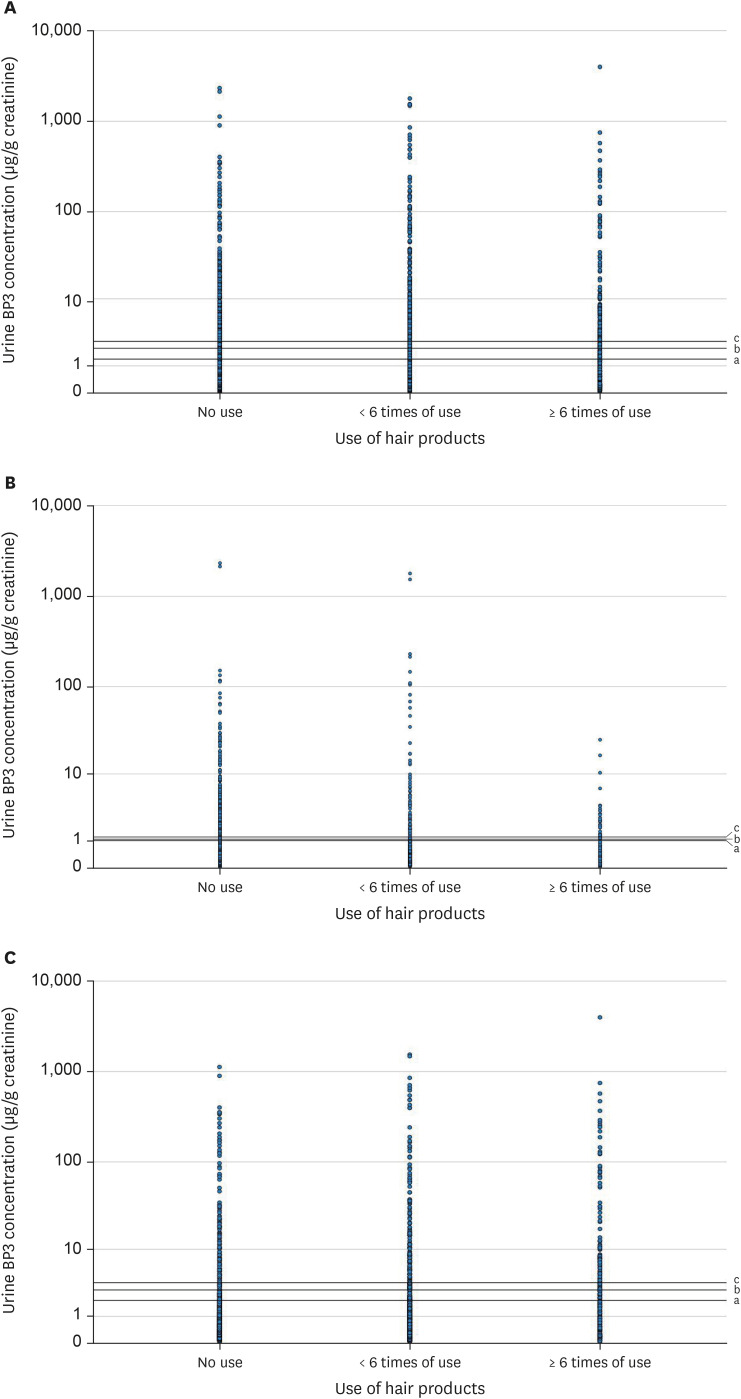
Scatter plot of urine BP3 concentration vs. use of hair products.
(A) Scatter plot of urine BP3 concentration vs. use of hair products in total participants (n = 3,796). (B) Scatter plot of urine BP3 concentration vs. use of hair products in men (n = 1,780). (C) Scatter plot of urine BP3 concentration vs. use of hair products in women (n = 2,016).
BP3: benzophenone-3.
Analysis of variance was used to calculate the mean concentration of urine benzophenone-3. The mean concentration of urine benzophenone in total participants were 7.8 ± 0.2 μg/g Cr (no use), 21.5 ± 1.6 μg/g Cr (< 6 times of use), 16.6 ± 0.5 μg/g Cr (≥ 6 times of use) (p < 0.001). The mean concentration of urine benzophenone in men were 6.5 ± 0.1 μg/g Cr (no use), 20.6 ± 0.5 μg/g Cr (< 6 times of use) and 0.9 ± 0.0 μg/g Cr (≥ 6 times of use) (p < 0.001). The mean concentration of urine benzophenone in women 10.1 ± 0.6 μg/g Cr (no use), 22.1 ± 2.8 μg/g Cr (< 6 times of use) and 24.4 ± 0.8 μg/g Cr (≥ 6 times of use) (p < 0.001).
Table 3 shows the calculated OR values for high urine benzophenone-3 concentration according to the frequency of using hair products. The value of OR was higher in women with higher frequency of using hair products. The adjusted OR values were 1.24 (95% confidence interval [CI]: 1.12–1.38) in the group with < 6 times of use and 1.54 (95% CI: 1.33–1.79) in the group with ≥ 6 times of use. The OR values were not significant in men. Furthermore, additional OR values for urine benzophenone-3 concentration according to the 50th percentile concentration, with the frequency of using hair products are detailed in Supplementary Table 2.
DISCUSSION
This study investigated the association between the use of hair products and urine benzophenone-3 concentration. The results showed that women with hair product usage of < 6 times or ≥ 6 times had a higher OR for high urine benzophenone-3 concentration than women with no usage of hair products. In a study involving 168 Korean adults who used cosmetic products containing benzophenone-3, urine benzophenone-3 concentration was higher in users (0.00576 μg/g Cr) than nonusers (0.00292 μg/g Cr).16 In a study using data from the National Health and Nutrition Examination Survey to represent the general US population, the mean concentration of urine benzophenone-3 in the group who never uses sunscreen was 9.3 µg/g Cr, while in the group who always used sunscreen was 116.8 µg/g Cr.17 The results of these previous studies were in line with the results of this study. So, urine benzophenone-3 can be used as a key indicator in the assessment of exposure to benzophenone-3 through hair products.
As an endocrine-disrupting chemical, benzophenone-3 is known to be associated with reproductive toxicity, developmental toxicity, thyroid toxicity, and endocrine toxicity.22526 Benzophenone-3 is also known to be associated with uterine fibroids,27 endometriosis,28 hypothyroidism,232930 lung cancer,31 and precocious puberty in both boys and girls.323334 Also, benzophenone-3 can induce skin irritation,35 photoallergic contact dermatitis,36 and cheilitis.37
Benzophenone-3 is used in hair products as it can absorb UV light to prevent degradation of hair products and protect the skin. According to a study conducted in the US, benzophenone-3 was found in 8 out of 279 shampoos (2.9%), 7 out of 231 conditioners (3.0%), and 25 out of 286 hair-styling products (9.0%).38 In another study investigating 4,489 hair-care products registered in an online shop, < 10% of benzophenone-3 was detected in 1,363 conditioners (30.3%), 1,479 hair-styling products (32.9%), and 53 other hair products (1.2%).39 Among aerosol hairsprays, 0.014% of benzophenone-3 was detected, and pump hairsprays had up to 0.05% of benzophenone-3.40 Therefore, as hair products contain varying concentrations of benzophenone-3, the risk of benzophenone-3 exposure when using hair products cannot be ignored.
The routes of human exposure to benzophenone-3 include skin absorption,2441 food intake,4243 and respiratory inhalation.7 Among them, the main route is skin absorption.2444 When applying benzophenone-3 to skin for 4 hours, the skin permeability was 35%.40 In another study, after 30 minutes of skin application, benzophenone-3 was detected in the stratum corneum at 4% of the applied amount.40 When hair products are used, benzophenone-3 can be absorbed through the scalp and forehead. Because, first, benzophenone-3 has low volatility due to its low vapor pressure at ambient temperature (0.0005 Pa at 20°C).45 Hence, benzophenone-3 can stay attached to the scalp for a long time with low evaporation. Based on Fick’s law of diffusion stating that particles move from a high concentration area to a low concentration area, benzophenone-3 on the scalp permeates into the stratum corneum, skin surface lipid, and viable epidermis.46 Second, the scalp and forehead exhibit more pores than other skin areas, with the scalp having particularly large pores, allowing ready permeation of lipophilic materials.4748 Benzophenone-3 can easily permeate into the scalp and forehead due to its lipophilic property, reflected on the logarithmic n-octanol/water partition coefficient (LogKow) of 4.0.251825 Therefore, the use of hair products that contain benzophenone-3 enables the absorption of benzophenone-3 through the scalp and forehead.
The components in hairspray products are released in the form of aerosol.40 Approximately 85% of aerosol particles attach to the scalp and forehead upon a single spray.4950 It is known that aerosols with aerodynamic equivalent diameter (da ) < 10 μm can reach the lungs.49 However, the da of pump-type hairspray aerosol is 60–80 μm and that of propellant hairspray is 25–50 μm.404951 Hence, 95–99% of the hairspray aerosols exhibit da > 10 μm.4049 Therefore, benzophenone-3 in hairsprays is unable to enter the lungs and become deposited in nasopharyngeal and bronchial regions.404950 Consequently, benzophenone-3 in hairspray is absorbed through the lungs to a limited extent, highlighting the importance of exposure via skin absorption.
Benzophenone-3 is metabolized mainly in the liver via Phases I and II.24152 Phase I involves hydroxylation, oxidation, and reduction, whereby various benzophenone derivatives are generated.21853 Phase II involves a conjugation process to increase the water solubility of benzophenone and allow its release in urine.21853 Benzophenone-3 is detected in urine 3 hours after skin absorption,54 while the blood benzophenone-3 concentration reaches its maximum after 4 hours.53 The scalp, in particular, may show a rapid increase in blood benzophenone-3 considering its high vascularity.55 It is thus presumed that, while benzophenone-3 is rapidly absorbed, the relatively long biological half-life of approximately 79.2 hours1056 implies that repeated use of hair products would lead to a continuous influence of benzophenone-3.357
In this study, the association between urine benzophenone-3 and hair products was observed in women only. In a study conducted in China, the level of benzophenone-3 detected in hair was higher in women than in men, attributed to the more frequent use of hair products and longer hair length in women.5859 So, we presumed that urine benzophenone-3 was associated with only women, who applied a greater amount of hair products than men during a single use. Likewise, higher concentrations of benzophenone-3 were found in women than in men in this study. First, in this study, urine benzophenone-3 was calculated by dividing it with urine creatinine concentration for adjustment for urine dilution. Due to low urine creatinine concentration in women, urine benzophenone-3 concentration was higher in women.60 Second, women apply greater amount of cosmetics including hair products, UV filters, and make-up products than men, which inevitably increases urine benzophenone-3 concentration.5859
The limitations of this study are as follows. First, as a cross-sectional investigation, this study was limited in clearly identifying the cause-effect relationship. Second, work-related variables such as the work environment and wearing of protective gear were not analyzed in this study. Third, the type and amount per use of hair products were unknown so that the level of exposure could not be accurately estimated. Specifically, the definition of hair products was not clear so this could have caused the possibility of occurrence of exposure inaccuracies. Lastly, as the data in this study were based on a questionnaire, the potential for deviation according to the memory and recall of participants cannot be ignored.
To the best of our knowledge, no large-scale study has been conducted on the association of use of hair products with urine benzophenone-3 in the South Korean population. This study is thus significant in determining the association between hair products and urine benzophenone-3 using data representative of general Korean population. Based on this study, continuous monitoring of benzophenone-3 exposure through the use of hair products is necessary.
Acknowledgements
This study used the Korean National Environmental Health Survey Cycle 4 (2018–2020), made by National Institute of Environmental Research (NIER-2020-01-01-016). We appreciate National Institute of Environmental Research for making the raw data of Korean National Environmental Health Survey available.
Notes
Funding: This research was supported by the Soonchunhyang University Research Fund and Inha University Hospital’s Environmental Health Center for Training Environmental Medicine Professional funded by the Ministry of Environment, Republic of Korea (2024).
Competing interests: The authors declare that they have no competing interests.
Authors contributions:
Conceptualization: Kim S, Cho SY.
Data curation: Kim S, Kang J, Huh SW.
Formal analysis: Kim S, Park HW.
Investigation: Cho SY.
Methodology: Yoon S.
Software: Kim S, Cho SY, Kang J.
Validation: Kim S, Cho SY, Kim D.
Writing - original draft: Kim S, Cho SY.
Writing - review & editing: Kim S, Cho SY.
Abbreviations
BMI
body mass index
BP3
benzophenone-3
CI
confidence interval
Cr
creatinine
KoNEHS
Korean National Environmental Health Survey
IRB
Institutional Review Board
OR
odds ratio
PET
polyethylene terephthalate
UV
ultraviolet
References
SUPPLEMENTARY MATERIALS
Supplementary Table 1
Quartile concentration of benzophenone-3 according to the use of hair products in total, men, and women
Supplementary Table 2
Adjusted odds ratios and 95% confidence interval of use of hair products with 50th percentile concentration of urine benzophenone-3

